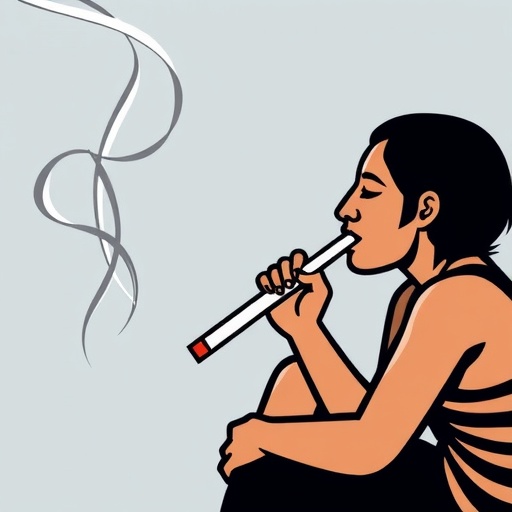In an evolving healthcare landscape, where the need for culturally relevant interventions is paramount, a groundbreaking study seeks to address the alarming rates of tobacco use among Aboriginal populations. Researchers, led by K. Sharrad and colleagues, have embarked on a comprehensive mixed-methods investigation aimed at developing tailored smoking cessation resources for Aboriginal people who smoke tobacco and their healthcare providers. This initiative not only recognizes the unique cultural contexts of Aboriginal individuals but also aims to foster a collaborative approach between these individuals and their healthcare professionals.
The prevalence of smoking in Aboriginal communities remains disproportionately high, contributing to a significant burden of chronic diseases. Health disparities in these populations are often compounded by historical injustices and socio-economic challenges. Recognizing the urgency of this public health crisis, the team conducted an extensive literature review to understand existing cessation programs and their limitations when tailored to Aboriginal communities.
In the initial phase of the study, qualitative interviews were performed with Aboriginal smokers and healthcare providers to gather insights into their experiences with smoking and cessation attempts. Participants shared personal stories, revealing the deep-rooted cultural significance of tobacco in some Aboriginal traditions, complicating cessation efforts. The research highlighted that smoking is often intertwined with social norms, identity, and coping mechanisms, making it crucial for cessation resources to respect these cultural dimensions.
Simultaneously, quantitative surveys were distributed to gather more extensive data on smoking behaviors, attitudes towards cessation, and barriers encountered in seeking help. This mixed-methods approach allowed the research team to triangulate data and draw more nuanced conclusions about the challenges faced by Aboriginal smokers and the healthcare providers who seek to assist them.
As the study progressed, the research team embarked on the daunting task of synthesizing qualitative and quantitative findings. They began to identify patterns in the data, revealing critical barriers to cessation, including stigma, lack of culturally appropriate resources, and a general distrust of the healthcare system. These findings underscored the necessity of developing resources that not only educate but also build trust within Aboriginal communities.
Based on these insights, the team set out to design novel smoking cessation resources tailored specifically to the needs of Aboriginal smokers. This involved collaborating with Aboriginal leaders, healthcare practitioners, and community stakeholders to ensure that the materials developed would resonate culturally and practically. The evolving resources emphasized the importance of culturally-grounded approaches, integrating traditional knowledge where appropriate, and recognizing tobacco’s complex role within these communities.
Additionally, recognizing that healthcare providers play a pivotal role in supporting Aboriginal smokers, the researchers designed complementary resources aimed at enhancing provider competence in delivering cessation support. Training modules were developed to equip healthcare professionals with the skills needed to engage effectively with Aboriginal clients, appreciate the cultural significance of tobacco, and offer empathetic support tailored to individual circumstances.
Moreover, the study highlighted the need for ongoing evaluation of the developed resources to ensure their effectiveness and relevance. As the researchers prepare for the implementation phase, a feedback mechanism has been established, allowing communities to continuously inform and refine the resources based on their experiences and outcomes. This commitment to iterative improvement reflects an understanding that smoking cessation is not a one-size-fits-all approach but rather a dynamic process influenced by numerous factors.
The implications of this research extend beyond individual health outcomes; they signal an essential shift in public health strategy towards more inclusive and culturally sensitive practices. By addressing the social determinants of health and recognizing the historical context of tobacco use within Aboriginal communities, the developed resources set a precedent for future health initiatives aimed at reducing disparities and promoting equity.
As the deployment of these resources approaches, the researchers are optimistic about their potential impact. They anticipate that such targeted interventions could not only improve cessation rates among Aboriginal smokers but also foster stronger relationships between these communities and healthcare providers. By prioritizing collaboration and respect for cultural values, this study exemplifies a revolutionary approach to tackling tobacco use and its associated health burdens.
In conclusion, the ongoing research led by K. Sharrad and colleagues represents a pivotal step towards empowering Aboriginal individuals in their smoking cessation journeys. By integrating cultural understanding with empirical research, the study sets a new standard for health interventions within marginalized populations. As we await the results of the implementation, one thing is clear: the path towards effective smoking cessation for Aboriginal smokers is being paved with a foundation of respect, collaboration, and cultural competence.
Subject of Research: Development of smoking cessation resources for Aboriginal people.
Article Title: Developing novel smoking cessation resources for Aboriginal people who smoke tobacco and their healthcare providers: a mixed methods study.
Article References:
Sharrad, K., Stewart, S., Marlow, N. et al. Developing novel smoking cessation resources for Aboriginal people who smoke tobacco and their healthcare providers: a mixed methods study.
BMC Health Serv Res (2025). https://doi.org/10.1186/s12913-025-13568-x
Image Credits: AI Generated
DOI:
Keywords: Aboriginal health, smoking cessation, mixed methods research, cultural competence, public health interventions.




